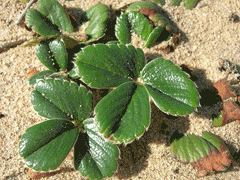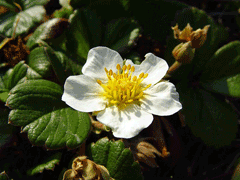 |
|
http://www.flickr.com/people/38213125@N00 |
 |
| http://www.flickr.com/photos/78425154@N00 |
Translate this page:
Summary
Fragaria is a genus of prostrate to small flowering plants in the rose family commonly known as strawberries for their edible fruits. The taste of strawberries varies by species and cultivar, ranging from sweet to tart. Strawberries have vitamin C and half as much iron as spinach. Many species of strawberry are excellent food forest plants tolerating moderate shade and are good ground covers. All Fragaria species mentioned provide food or shelter for beneficial birds or other vertebrates, are generalist nectary plants and are dynamic accumulators. Harvest fruit in summer and autumn. Leaves through the year. Fruit production begins three months after planting and may continue for up to 5 years. Some strawberry varieties are self-fertile, while others require cross-pollination for optimal fruit production.
Beach Strawberry (F. chiloensis) (Native: Western Americas) has a large, sweet, succulent fruit with a delicate flavour. Use the leaves for tea. It is a perennial ground cover acting as a firebreak as it provides little fuel.
Physical Characteristics

 Fragaria chiloensis is a PERENNIAL growing to 0.3 m (1ft) at a fast rate.
Fragaria chiloensis is a PERENNIAL growing to 0.3 m (1ft) at a fast rate.
See above for USDA hardiness. It is hardy to UK zone 4 and is not frost tender. It is in flower from April to May, and the seeds ripen from June to July. The species is dioecious (individual flowers are either male or female, but only one sex is to be found on any one plant so both male and female plants must be grown if seed is required). and is pollinated by Insects. The plant is not self-fertile.
It is noted for attracting wildlife.
Suitable for: light (sandy), medium (loamy) and heavy (clay) soils and prefers well-drained soil. Suitable pH: mildly acid, neutral and basic (mildly alkaline) soils. It can grow in semi-shade (light woodland) or no shade. It prefers moist soil. The plant can tolerates strong winds but not maritime exposure.
UK Hardiness Map
US Hardiness Map
Synonyms
F. cuneifolia.
Plant Habitats
Woodland Garden Sunny Edge; Dappled Shade; Ground Cover; Cultivated Beds;
Edible Uses
Edible Parts: Fruit
Edible Uses: Tea
Fruit - raw or cooked[2, 27, 101, 183, 257]. Large, sweet and succulent with a delicate flavour[183]. A delicious treat[K]. The berries can be used to make jams, preserves etc[257]. A tea can be made from the leaves[257].
References More on Edible Uses
Medicinal Uses
Plants For A Future can not take any responsibility for any adverse effects from the use of plants. Always seek advice from a professional before using a plant medicinally.
Antiseptic Astringent Emmenagogue Galactogogue Odontalgic
The plant is antiseptic, astringent, emmenagogue, galactogogue and odontalgic[172]. It has been used to regulate the menstrual cycle[172]. A poultice of the chewed leaves has been used to treat burns[257].
References More on Medicinal Uses
The Bookshop: Edible Plant Books
Our Latest books on Perennial Plants For Food Forests and Permaculture Gardens in paperback or digital formats.

Edible Tropical Plants
Food Forest Plants for Hotter Conditions: 250+ Plants For Tropical Food Forests & Permaculture Gardens.
More

Edible Temperate Plants
Plants for Your Food Forest: 500 Plants for Temperate Food Forests & Permaculture Gardens.
More

More Books
PFAF have eight books available in paperback and digital formats. Browse the shop for more information.
Shop Now
Other Uses
Agroforestry uses:
Strawberries can serve as ground cover, helping to prevent soil erosion. They can also be integrated into mixed cropping systems to enhance biodiversity. Plants spread by means of runners and can be grown as a ground cover[208]. A dynamic accumulator gathering minerals or nutrients from the soil and storing them in a more bioavailable form - used as fertilizer or to improve mulch. seedy fruit loved by birds. Perennial groundcover for zone 2 firebreaks. The US government has created a system of firebreaks for areas prone to wildfires, theses are separated into concentric zones surrounding buildings. Zone 2 is the second away from the house. These low-level ground covers provide little fuel. 1. Nectary - Flowers rich in nectar and pollen:
Yes – Strawberry flowers are rich in nectar and pollen, attracting various pollinators like bees and butterflies.
2. Wildlife - Food (Fruit, Seeds, Leaf litter, Shelter, Nesting, Roosting):
Yes – Strawberries provide food in the form of fruit for birds and other wildlife. The plants can also create some ground cover and habitat.
3. Invertebrate Shelter (Overwintering sites, Leaf litter, Groundcover):
Yes – Strawberries can provide shelter for invertebrates and the leaf litter can contribute to habitat diversity.
4. Pest Confuser (Smell):
No – Strawberries do not have a strong smell that would effectively confuse or deter pests.
Special Uses
Dynamic accumulator Food Forest Ground cover
References More on Other Uses
Cultivation details
Prefers a fertile, well-drained, moisture retentive soil in a sunny position[27, 200]. Tolerates semi-shade though fruit production will be reduced. Grows best near the coast[27]. Plants like a mulch of pine or spruce leaves[18]. Cultivated for its edible fruit in the Andes[61]. This species, along with F. virginiana, is probably a parent of the cultivated strawberries[46]. Dioecious. Male and female plants must be grown if seed is required. For polyculture design as well as the above-ground architecture (form - tree, shrub, etc. and size shown above), information on the habit and root pattern is also useful and given here if available. An evergreen. The plant growth habit is a runner spreading indefinitely by rhizomes or stolons [1-2]. The root pattern is fibrous dividing into many fine roots [1-2]. The root pattern is stoloniferous rooting from creeping stems above the ground [1-2]. Heat zone 9-1. Can be mown in early spring. Some strawberry varieties are self-fertile, while others require cross-pollination for optimal fruit production. Strawberries are typically harvested in late spring to early summer depending on the variety and climate.
Strawberries usually flower in spring.
Strawberries grow relatively quickly, with plants producing fruit within the first year of planting, especially when propagated through runners.
References Carbon Farming Information and Carbon Sequestration Information
Temperature Converter
Type a value in the Celsius field to convert the value to Fahrenheit:
Fahrenheit:
The PFAF Bookshop
Plants For A Future have a number of books available in paperback and digital form. Book titles include Edible Plants, Edible Perennials, Edible Trees,Edible Shrubs, Woodland Gardening, and Temperate Food Forest Plants. Our new book is Food Forest Plants For Hotter Conditions (Tropical and Sub-Tropical).
Shop Now
Plant Propagation
Seed - sow early spring in a greenhouse. The seed can take 4 weeks or more to germinate. The seedlings are very small and slow-growing at first, but then grow rapidly. Prick them out into individual pots when they are large enough to handle and plant them out during the summer. Division of runners, preferably done in July/August in order to allow the plants to become established for the following years crop[200]. They can also be moved in the following spring if required, though should not then be allowed to fruit in their first year. The runners can be planted out direct into their permanent positions.
Other Names
If available other names are mentioned here
Native Range
NORTHERN AMERICA: United States, Alaska (s. (coastal)), Oregon (coastal), Washington (coastal), California (coastal), Canada, British Columbia (coastal), SOUTHERN AMERICA: Argentina (south), Chile (south), PACIFIC: United States, Hawaii,
Weed Potential
Right plant wrong place. We are currently updating this section.
Please note that a plant may be invasive in one area but may not in your area so it's worth checking.
Conservation Status
IUCN Red List of Threatened Plants Status :

Growth: S = slow M = medium F = fast. Soil: L = light (sandy) M = medium H = heavy (clay). pH: A = acid N = neutral B = basic (alkaline). Shade: F = full shade S = semi-shade N = no shade. Moisture: D = dry M = Moist We = wet Wa = water.
Now available:
Food Forest Plants for Mediterranean Conditions
350+ Perennial Plants For Mediterranean and Drier Food Forests and Permaculture Gardens.
[Paperback and eBook]
This is the third in Plants For A Future's series of plant guides for food forests tailored to
specific climate zones. Following volumes on temperate and tropical ecosystems, this book focuses
on species suited to Mediterranean conditions—regions with hot, dry summers and cool, wet winters,
often facing the added challenge of climate change.
Read More
Expert comment
Author
(L.)Duchesne.
Botanical References
71200
Links / References
For a list of references used on this page please go here
Readers comment
| Add a comment |
|
If you have important information about this plant that may help other users please add a comment or link below. Only comments or links that are felt to be directly relevant to a plant will be included. If you think a comment/link or information contained on this page is inaccurate or misleading we would welcome your feedback at [email protected]. If you have questions about a plant please use the Forum on this website as we do not have the resources to answer questions ourselves.
* Please note: the comments by website users are not necessarily those held by PFAF and may give misleading or inaccurate information.
To leave a comment please Register or login here All comments need to be approved so will not appear immediately.
|
Subject : Fragaria chiloensis
|
|
|
|